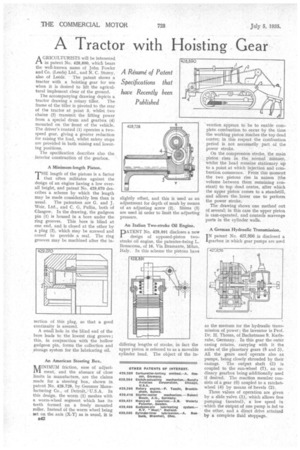A Tractor with Hoisting Gear
Page 52

If you've noticed an error in this article please click here to report it so we can fix it.
GRICULTURISTS will be interested 1-i.. in patent No. 428,890, which bears the well-known name of John Fowler and Co. (Leeds) Ltd., and N. C. Storey, also of Leeds. The patent shows a tractor with a hoisting gear for use when it is desired to lift the agricultural implement clear of the ground.
The accompanying drawing depicts a
tractor drawing a rotary tiller. The frame of the tiller is pivoted to the rear of the tractor at point 3, whilst two chains (2) transmit the lifting power from a special drum and gearbox (4) mounted on the front of the vehicle. The driver's control (1) operates a twospeed gear, giving a greater reduction for raising the load, whilst safety stops are provided in both raising and lowering positions.
The specification describes also the interior construction of the gearbox.
A Minimum-length Piston.
THE length of the pistons is a factor that often militates against the design of an engine having a low overall height, and patent No. 429,070 describes a scheme by which the length may be made considerably less than is usual. The patentees are G. and J. Weir, Ltd., and C. G. Pullin, both of Glasgow. In the drawing, the gudgeon pin (1) is housed in a bore under the ring grooves. This bore is blind at one end, and is closed at the other by a plug (2), which may be screwed and coned to provide a seal. The ring grooves may be machined after the in
sertion of this plug, so that a good continuity is assured.
A small hole in the blind end of the bore leads to the lowest ring groove; this, in conjunction with the hollow gudgeon pin, forms the collection and /storage system for the lubricating oil.
An American Steering Box.
MNIMUM friction, ease of adjustment, and the absence of close limits in manufacture, are the claims made for a steering box, shown in patent No. 428,728, by Gemmer Manufacturing Co., of Detroit, U.S.A. In this design, the worm (1) meshes with a worm-wheel segment which has its teeth formed on a freely mounted roller. Instead of the worm wheel being set on the axis (X-Y) as is. usual, it is
542 slightly offset, and this is used as an adjustment for depth of mesh by means of an adjusting screw (2). Shims (3) are used in order to limit the adjusting pressure.
An Italian Two-stroke Oil Engine.
PATENT No. 428,891 discloses a new design of opposed-piston twostroke oil engine, the patentee'4eing L. Bonacossa, of 16, Via Bramante, Milan, Italy. In this scheme the pistons have
vention appears to be to enable complete combustion to occur by the time the working piston reaches the top dead centre; in this respect the combustion period is not necessarily part of the power stroke.
On the compression stroke, the main piston rises in the normal manner, whilst• the head remains stationary up to a point at which injection and combustion commence. From this moment the two pistons rise in unison (the volume between them remaining constant) to top dead centre, after which the upper piston comes to a standstill, and allows the lower one to perform the power stroke.
The drawing shows one method out of several; in this case the upper piston is cam-operated, and controls scavenge ports in the cylinder walls.
A German Hydraulic Transmission.
I N patent No. 427,956 is disclosed a gearbox in which gear pumps are used
as the mernum for the hydraulic transmission of power ; the inventor is Prof. Dr. H. Thoma, of Bachstrasse 9, Karlsruhe, Germany. In this gear the outer casing rotates, carrying with it the axles of the planetary gears (8 and 5). All the gears used operate also as pumps, being closely shrouded by their casings. The output shaft (3) is coupled to the sun-wheel (7), an ordinary gearbox being additionally used if desired. The reaction member consists of a gear (6) coupled to a ratchetwheel (4) by means of bevels (2).
Three values of operation are given by a slide valve (1), which allows free pumping (neutral), a low speed in which the output of one pump is fed to the other, and a direct drive attained by a complete fluid stoppage.




















































































